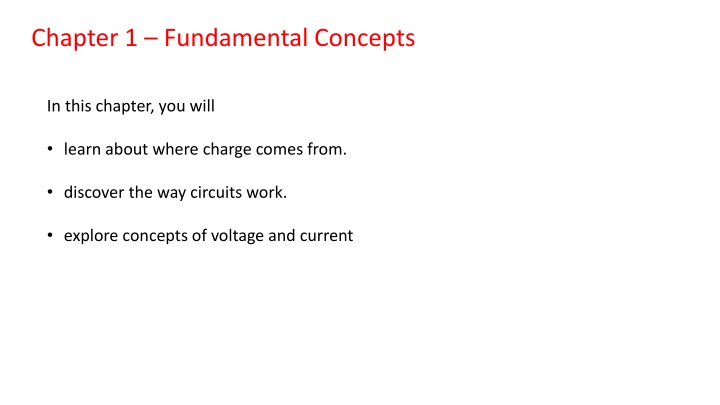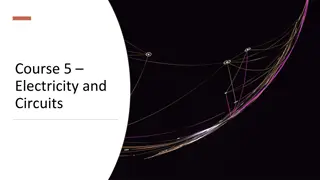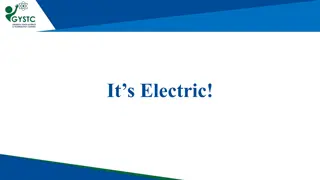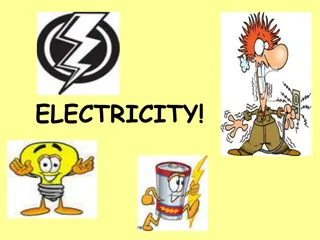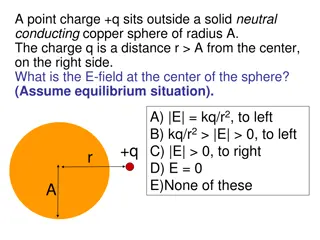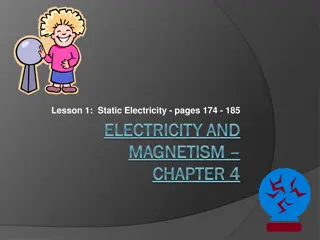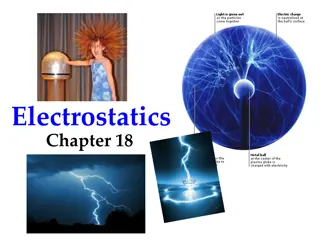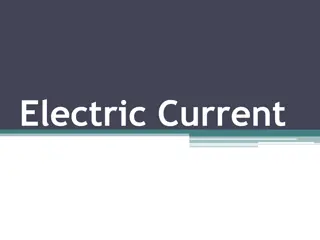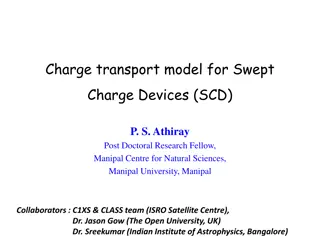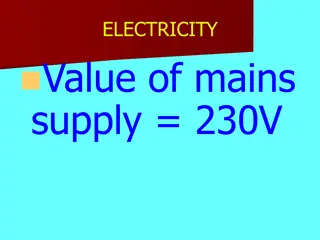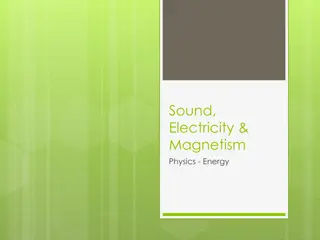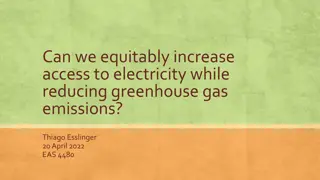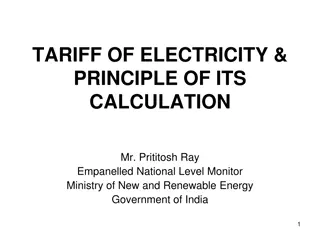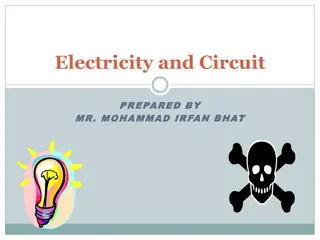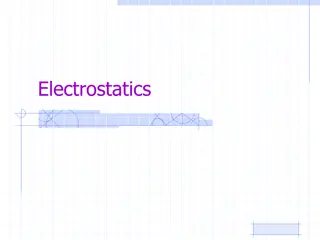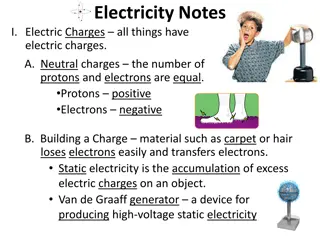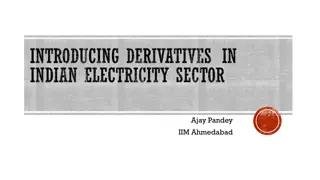Fundamental Concepts: Electricity and Charge
Electricity is a vital form of energy powering modern civilization. Explore the origins of charge, how it moves, and why materials conduct electricity differently. Understand the roles of protons, neutrons, and electrons in creating electric charges, and discover how valence electrons in conductors enable the flow of electricity.
Uploaded on Feb 22, 2025 | 0 Views
Download Presentation

Please find below an Image/Link to download the presentation.
The content on the website is provided AS IS for your information and personal use only. It may not be sold, licensed, or shared on other websites without obtaining consent from the author.If you encounter any issues during the download, it is possible that the publisher has removed the file from their server.
You are allowed to download the files provided on this website for personal or commercial use, subject to the condition that they are used lawfully. All files are the property of their respective owners.
The content on the website is provided AS IS for your information and personal use only. It may not be sold, licensed, or shared on other websites without obtaining consent from the author.
E N D
Presentation Transcript
Chapter 1 Fundamental Concepts In this chapter, you will learn about where charge comes from. discover the way circuits work. explore concepts of voltage and current
Humans have always been fascinated by the raw power of electricity. From the heating, to lighting, to plating metals, civilization has been taking advantage of this universal form of energy. Indeed, civilization could not exist as it does today without electricity But why do some materials seem to work better than others when it comes to making electricity flow? What is a volt, an amp, DC, AC? What is actually moving in the wire when a lamp is plugged into an outlet? In this chapter, we will explore the phenomenon that gives rise to electricity: charge. We will discover where charge comes from, and how it is made to move. We will explore why some materials block electricity, while other materials allow it to flow freely.
1.1 What is Electricity? Energy is all around us. It is present in the form of heat, light, and motion. Energy is defined as the ability to do work. Civilization would not have advanced as far as it has if not for the discovery of electricity. So what makes electricity? Electricity is defined as the buildup and motion of electric charges. Opposite charges want to combine, while like charges repel one another. So if we have a charged particle, we can move it by applying an electric field, which is an invisible force-field. Electric charge comes from the particles in atoms, the building blocks of matter. Atoms are composed of three types of particles. These are the proton, the neutron, and the electron, as shown below in Figure 1. Protons have a positive charge, neutrons have zero charge, and electrons have a negative charge. Protons and neutrons make up the nucleus (center) of the atom, and electrons orbit around this nucleus in layers called shells or orbitals. Protons and neutrons are far heavier than electrons, but in spite of this protons and electrons have equal and opposite charges.
Therefore, the number of protons must be equal to the number of electrons for an atom to have a net charge of zero. An atom which has lost or gained an electron can have a positive or negative charge, respectively. An atom at ground state (lowest energy) will have a net charge of zero. This is because the positive charges from the protons in the nucleus are equally balanced with the negative charges from the electrons in their orbitals. Some atoms have lots of protons and electrons, and the electrons furthest away from the nucleus can be bumped off easily when the atom gains energy. The outer shells of atoms are called valence orbitals, and the electrons in the outer shell are called valence electrons.
Valence electrons that gain enough energy can escape their valence orbitals and become free electric charges. They can move around in all directions between the spaces of the atoms, occasionally settling into a free valance orbital, only to be bumped off again. Materials where there is an abundance of free electric charges are called conductors. Metals have an abundance of free electrons, so they are excellent conductors of electricity
Electrical conduction occurs when we cause all the free electrons to drift in the same direction, like water in a pipe. The electrons are still moving in random directions, but they have a net motion in the direction of the positive charge. The electromotive force (sometimes abbreviated EMF) that causes the electrons to move is called electric potential (denoted by capital E,) and is measured in volts (abbreviated V.) A potential difference applied to a wire from a battery will cause the free electrons to drift in the direction of the positive charge, and away from the negative charge, as shown in Figure 2.
When electric charges are in motion, we call this electric current (denoted by capital I). Electric current has units of amperes or amps (abbreviated A.) One amp is one coulomb of electric charge passing through a given point in a conductor per second. A coulomb (abbreviated C) is a very large number of discrete charges, so it is more convenient to use amperes. So voltage is the pressure that moves the electrons in a conductor, and current is the motion of the electrons. 1 C is defined as 6.24 ?1018 The electrical devices found in your home have ratings for voltage and current. A typical light bulb in a lamp requires 220 volts AC, or 220 VAC (we will discuss alternating current later.) Fuses and circuit breakers are designed to shut off a circuit when maximum current has been exceeded. These may be rated anywhere from 10 A to 20 A for residential power.
The USB cables from your computer provide +5 VDC (volts, direct current) to phones and other devices for charging. And the remote control on your coffee table may operate on AA or AAA batteries, which provide 1.5 V each. But there is a big difference between the power coming out of your wall socket and battery power. We will discuss this difference in the next section.
Chapter 1.2: An Introduction to Circuits, Schematics, and Basic Terms. In the previous section, we discussed how free charges can be made to flow in a conductor. In order for charges to flow, a complete path must be provided. Electricity must flow in a circuit, that is, it must flow in a closed loop from the power source to the device being powered, and then back to the power source. If we break the wires anywhere between the power source and the circuit, no current will flow. The air around you has very few free electrons, so air is a pretty good insulator. Insulators keep unwanted electrical contacts from occurring. The plastic and rubber on wires are an example of insulators. So opening a switch breaks the contact and current will stop flowing.
The drawings shown in Figure 3 above are special types of drawings that electronics engineers and technicians use. They are called pictorial diagrams and schematic diagrams. Pictorial diagrams show the physical layout for parts placement, and schematic diagrams show symbolic circuit connections. Both the schematic diagram and pictorial diagram shown above describe exactly the same circuit. It may seem difficult at first, but don't worry. You will be learning all about schematics as you progress through this course.
The circuit shown in Figure 3 is a simple light with a switch to turn it on and off. A battery supplies power to the circuit. Though the electrons are moving through the wire away from the negative terminal and towards the positive terminal, engineers consider current flow to start at the positive terminal (this is backwards!) In electronics, it is conventional to show current flowing from positive to negative. This is due entirely to historical reasons. This can be confusing at first, but all schematic symbols are understood to use conventional current. Therefore, diodes and other directional devices are shown pointing in the direction opposite of actual current flow. Understanding conventional current is very important, but just remember that electrons are moving in the opposite direction. Don't worry, you'll get the hang of it. Conventional current will be used throughout this text
You have probably heard the terms alternating current and direct current, or abbreviated AC and DC. Direct current does not change direction. The constant voltage and current that a battery provides is a good example of DC. Alternating current changes direction periodically, or in a repeating fashion. See Figure 4 below. The wall sockets in your home provide alternating current. You may be asking why alternating current is used rather than direct current to provide power to your appliances. This has to do with the way power is delivered. The electric company transmits power on high voltage power lines that run for many miles. This is because high voltages are needed to overcome the resistance of the transmission lines. But the voltage must be stepped down using power line transformers, and transformers require alternating current to operate.
From the figure above, we can see that an AC signal has a voltage that periodically changes from positive to negative, from +4 V to -4 V. The figure above also shows a constant DC voltage of +3 V, on the right. This is usually a sine wave (as in the trigonometric function) but can be any function. Direct current is current that flows in only one direction, and is usually constant. The study of alternating and direct current circuits is called analog circuit theory, and we will be going into this in detail later.
Vocabulary Questions 1. The building blocks of matter are called ________________. 2. The ________________ (or center) of an atom, contains protons, and may contain neutrons. 3. ________________ have positive charge, while ________________ have negative charge. 4. A __________________ has an abundance of free electric charges that can flow. 5. When electrons are encouraged to drift in a direction, this flow is called __________________. 6. ____________________________ is current that changes direction periodically. 7. The unit of measure of electric potential is the ___________________. 8. The unit of measure of electric current flow is the ___________________. 9. An ________________ prevents current flow, and keeps conductors from making contact. 10. ________________ electrons are electrons found in the outermost orbitals of atoms. 11. The unit of electric charge is the ____________________, abbreviated C. 12. A _____________________________ is a symbolic diagram showing electrical connections.
True or False 1. Alternating current is a steady, constant current. T F 2. Neutrons have a charge of zero. T F 3. A circuit is a complete path for current to flow. T F 4. Electrons are heavier than protons and neutrons. T F 5. Valence orbitals are found closest to the nucleus of atoms. T F 6. Insulators are made of non-conductive materials. T F 7. Conventional current is understood to flow from positive to negative. T F 8. The ground state of an atom is it's lowest energy state. T F 9. Like charges attract, and opposite charges repel one another. T F 10. The electrical outlets in your home provide direct current. T F
